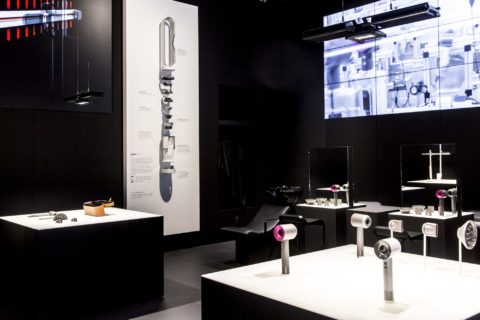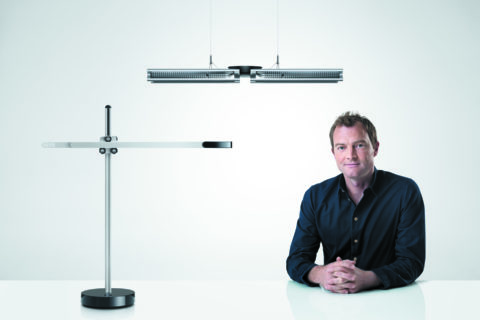Jake Dyson on Fascination, Beauty and the Constant Drive for Reinvention
“It’s about being able to look at a product and have some indication of how it works when you look at it.”
Jake Dyson is the charming British chap who happens to have invented a light fixture that burns for 40 years before needing to be replaced – and before we go any further, yes his surname means that Dyson. Jake is the son of James Dyson, the eccentric industrial designer whose eponymous appliance brand invented bagless vacuum cleaners in the 1980s, bladeless fans in the 2000s and the Supersonic hair dryer that looks more like a space tool than a common blow dryer in 2016. Dyson’s engineering fuses paragon efficiency with stunning minimalist design. (We’ve already determined that the $599 price tag for their humidifier is worth it.) Each Dyson product has a streamlined, instantly recognizable design that appeals to tech nerds and hardcore minimalists alike. We caught up with Jake Dyson at the launch of Dyson’s new store at Toronto’s Yorkdale Mall about beauty, fascination, and what life lessons can be gleaned when you’ve spent your entire life dedicated to innovation.

Dyson is known not only for efficiency but also aesthetics. What informs the aesthetic vision behind Dyson’s products?
What we do is we build around the parameters that provide the best performance. It’s very much a form follows function rule. Geometry forms the visual of the products. They’re intersecting circles, radiuses, there’s nothing morphic about them. They look completely different from anyone else’s products because of the shapes and forms. Dyson is very artistic because my father is quite eccentric. It’s art as well as design, fundamentally engineering and science. It’s about being able to look at a product and have some indication of how it works when you look at it. What that creates, in my opinion, is fascination, and I think that fascination becomes beauty.
What’s the emotional impact of working on a product that has married form with function?
There’s a wow factor. When you see the dirt fly up or the air coming out of a machine that you can’t see any blades, its quite magical. It’s a form of magic.
I understand you’re the genius behind Dyson’s new minimalist LED lights?
My ambition is to improve the way we light spaces. To make lighting healthier for people, less artificial, and to stop this light shining in your eyes with spotlights on your ceilings and ridiculous quantities of lights. I want to make them last a very, very long time and more energy efficient. The suspension lights last 40 years without any servicing. Those things are the motive behind the direction we are taking lighting in.

With this drive for constant reinvention, what kind of struggles have you come up against?
Well there’s always struggle every time we embark on something. You never quite know if you’re going to achieve or solve a problem but that’s what makes it exciting. That’s why it took my father 10 years to develop a vacuum cleaner. It’s a long time game.
What drives you to keep creating?
The desire to solve problems and make things better. [Dyson] is not interested in banging a product out with incremental improvements. We want to landslide the improvements and make the consumer’s life better. That’s the motive.
Does that bravery come from your dad? Is it in your DNA?
[My dad] is very, very cool. When he picked me up from school, he had all-coloured socks and was far trendier than anyone else’s parents. He loved designer furniture, though he couldn’t afford it, so we were kind of surrounded by design and creativity. My mom’s an artist, a rug designer, my brother is a musician, and my sister is a fashion designer. I ended up being a product designer, it was the only thing I was good at. So we are all artistically affected. I was brought up in that environment. It’s part of us.

What direction will your work take you in next?
We’re in this wonderful position where if we want to go into a new area, we’re got the freedom to learn things from scratch. We can spend the time to understand things properly, not under pressure by commercial shareholders. We’ve had hundreds of scientists working in laboratories for five years now on hair. We are starting understand hair. Because of what we’ve learned it’s given us new ideas. We can start to tell people what’s right for their hair, why their hair is not as good as they want to. It’s already coming into the product now.
You’ve piqued our interest.
It’s going to be an exciting year.








